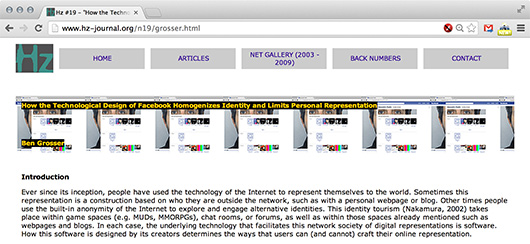My article “How the Technological Design of Facebook Homogenizes Identity and Limits Personal Representation” was just published in the journal Hz. A summary:
This paper has shown how Facebook homogenizes identity and limits personal representation, all in the service of late capital and to the detriment of gender, racial, and ethnic minorities. The company employs its tools of singular identity, limited self-description, and consistent visual presentation in order to aggregate its users into reductive chunks of data. These data describe people not as the complex social and cultural constructions that they are, but instead as collections of consumers to be marketed to and managed. There are many reasons the company has made these choices, including the demographics of its software development staff and its capitalistic imperative to monetize its database. However, to fully understand how this new digital juggernaut functions it is important to analyze the core component at the heart of it: software. Software is built by humans but also produces new types of thinking that lead to specific types of interfaces. In the case of Facebook, these interfaces are taking the vast promise of an internet-enabled space of tolerance and, in new ways, imposing age-old practices of discrimination. By exploring software as part of our larger cultural history we can begin to envision new ways of thinking that might help us break away from old ideas in our new digital culture.
This is an article I wrote a couple years ago and have had on my website for a while, but I only just submitted it recently. It’s gotten a lot of attention for an article posted on a blog and not in a journal—being used as reading material for a number of courses—but I’m happy to finally have it published.
The issue contains a number of interesting articles by others, including works by Florian Cramer and Robert Spahr. I encourage you to take a look.
